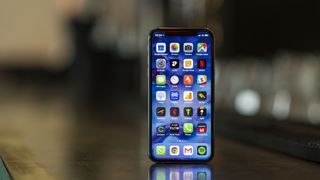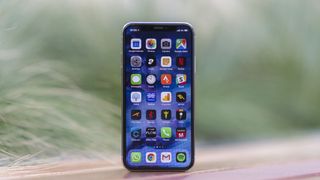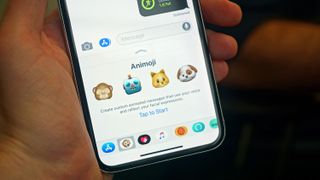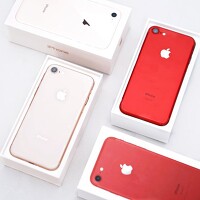iPhone X specs

Weight: 174g
Dimensions: 143.6 x 70.9 x 7.7 mm
OS: iOS 11
Screen size: 5.8-inch
Screen Resolution: 1125x2436
CPU: A11 Bionic
RAM: 3GB*
Storage: 64GB / 256GB
Battery: 2716mAh*
Rear camera: 12MP+12MP (both OIS)
Front camera: 7MP

Weight: 174g
Dimensions: 143.6 x 70.9 x 7.7 mm
OS: iOS 11
Screen size: 5.8-inch
Screen Resolution: 1125x2436
CPU: A11 Bionic
RAM: 3GB*
Storage: 64GB / 256GB
Battery: 2716mAh*
Rear camera: 12MP+12MP (both OIS)
Front camera: 7MP
iPhone X Price and release date
- Released on November 3
- The most expensive flagship phone on the market
- Comes in 64GB and 256GB options
It’s almost pointless to discuss the price of the iPhone X – it’s the most expensive flagship phone on the market, but iPhone users are more willing than most to look past cost.
But, while the focus here is going to be on the technology, we still need to at least mention the price and release date.
The iPhone X costs $999 / £999 / AU$1,579 for the basic, 64GB model. If you want the larger 256GB model it’s going to cost you $1,149 / £1,149 / AU$1,829 for the privilege.
If you want to buy the iPhone X you can already pre-order it – the window for doing so opened on October 27. We mention that because while the iPhone X release date was November 3, you probably won’t be able to get one for weeks or months now… that ship has sailed.
Screen
- By far the best screen on an iPhone
- Clear, vibrant colors
- Notch at top slightly irks, but doesn’t get in the way
The first thing you’ll notice about the new iPhone is hard to miss: the new screen blazes into your eyes the second you pick up the handset.
The 5.8-inch OLED display is, quite simply, by far the best thing Apple has ever crammed into an iPhone. It’s leaps ahead of the iPhone 8 and 8 Plus for so many reasons: the sharpness, the quality, the fact that it fills the whole front of the phone, and the color reproduction.
It’s also using a new, longer, screen, but while it looks larger than the iPhone 8 Plus’ 5.5-inch display on paper, it’s only marginally bigger in terms of actual screen real estate – it’s just stretched upwards.

OLED technology means you’re getting deeper blacks and more blinding whites, so everything from websites to the photos you take will look a little better.
Some will point to the fact that Samsung has been using OLED screens on its phones since the first Galaxy, but Apple counters that by saying it’s only now that the technology is good enough for its phones.
On the face of it that sounds defensive, but when you use the iPhone X you can see it’s a screen that’s incredibly, well, Apple. It’s not the sharpest or most colorful screen on a smartphone, but it’s clean, crisp and doesn’t suffer from terrible color shifts when you move it around. It’s a great screen to look at, and that’s what you want on a phone.
The term ‘bezel-less’ has been bandied about for the iPhone X, but that doesn’t really tell the right story. Yes, there are slight bands around the edges of the screen, but they don’t mar the experience – they give the fingers something to land on, preventing accidental touches of the screen.
Apple could reduce these further in the future and offer a more visually-appealing iPhone, but on the X the experience is still striking.
Talking of visual appeal, the notch at the top of the iPhone X is something that’s going to divide opinion, and that’s fair. Apple has taken this little chunk out of the top of the screen to house the new TrueDepth camera, and it encroaches on the display.
In portrait mode it’s hard to notice it’s there, and the way the notifications bar spills around it is nice. However, place the phone in landscape mode and it’s far more noticeable; it’s an irritant when you’re watching movies, as if we wanted to expand them to fill the screen (one of the real beauties of having a longer display) elements of the action were cut out by the notch.
While we’re talking about that longer screen, the 18:9 format is something we’ve seen on a number of other phones this year, and in the Android world the apps are largely encoded to fill the display just fine.
On the iPhone X, however, that’s not the case, with 99% of the apps we used packing massive black bars above and below the display, and those that were taking advantage of the aspect ratio displaying some glitches – Twitter, for instance, blocks out elements of your tweets.

The issue with apps using the black bars is that it makes the iPhone X look like any other handset from Apple – the screen is the main visual differentiator on this phone, and you want every app to fill the display nicely.
Yes, the iPhone X is only just out on the market, and developers will likely quickly code for the new device, but right now it’s just a bit disappointing to look at – it looks more like an iPhone 3GS than a 2017 model.
The new display on the iPhone X also showcases a new feature for Apple: HDR playback. The phone can show movies encoded in the HDR10 and Dolby Vision formats, and combined with the OLED display the images offer so much more depth and realistic color reproduction.
If you’re watching a scene with explosions in it, the effect is incredible on the iPhone X – much like with all OLED screens.
However, it’s inherently harder to make out detail in darker scenes in HDR movies – that’s something you’ll need to adjust to. Compared to the LCD screen of the iPhone 8 Plus, there are times when you can see less of the action, but compare them side by side and you’ll see that the overall richness, depth and quality for watching movies is just higher on the iPhone X.
Like the iPhone 8 and 8 Plus, the X uses a True Tone display, which mimics the lighting conditions around it and will adjust the white balance accordingly. It’s not a reason to buy the phone on its own, but it’s a really premium little extra that you’ll grow to like.
'Info. > Review' 카테고리의 다른 글
| 겔럭시 S10 제품군 리뷰 (Galaxy (0) | 2019.02.26 |
|---|---|
| iPhone XS·XR Review (0) | 2019.02.17 |
| 아이폰8 아이폰7 비교 (1) | 2017.11.01 |
| iPhone 6s review, Compare 6s with 6 (0) | 2015.10.02 |
| iOS 9 review (0) | 2015.09.17 |



